To treat gum disease with NIR therapy, start by ensuring good oral hygiene—brush, floss, and rinse regularly. Use a red and near-infrared light device according to the manufacturer's instructions, typically for 10-15 minutes, three to five times a week. This therapy enhances cellular repair, reduces inflammation, and promotes gum regeneration by increasing energy production in cells. With consistent use, you may notice improved gum health and reduced pain. Always consult a healthcare provider for personalized guidance to maximize your results. Stick around, and you'll discover even more effective strategies for better gum care.
Understanding Gum Disease
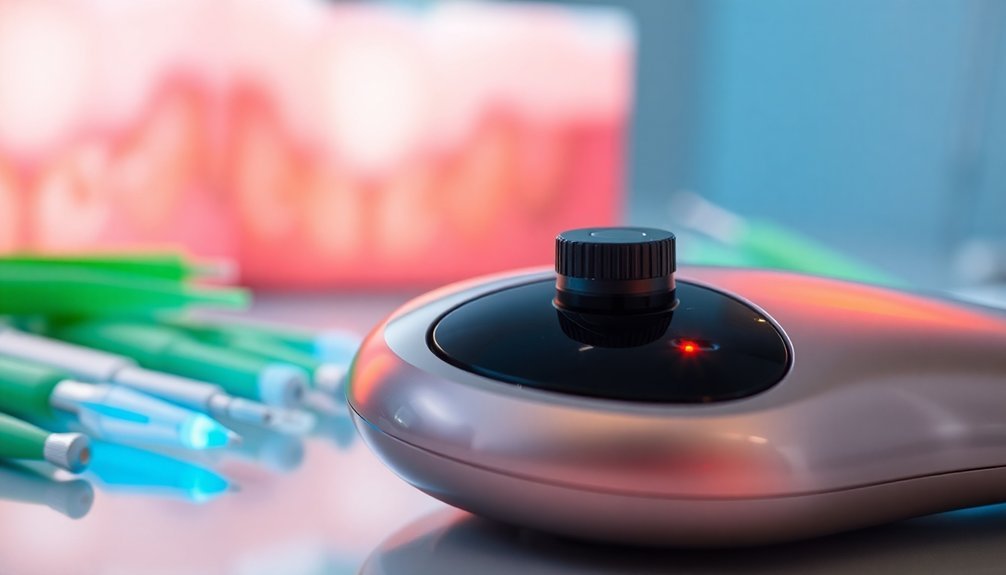
Understanding gum disease is vital because it can considerably impact your oral health. It starts with plaque buildup, a sticky film of bacteria that forms on your teeth, especially after eating sweet or starchy foods. If you neglect to brush, floss, and rinse with mouthwash, this plaque turns into tartar, which hardens along your gumline.
As bacteria release acids, they not only attack your tooth enamel but also irritate your gums, leading to inflammation.
Gum disease progresses through stages. Gingivitis is the earliest stage and can cause red, swollen, and bleeding gums, but it's reversible with proper care. If left untreated, it can develop into mild or moderate periodontitis, where bacteria invade the bones, creating painful pockets. Approximately 50% of adults aged 30 and older exhibit signs of gum disease, underlining the importance of awareness.
Advanced periodontitis can lead to severe damage, loose teeth, and even tooth loss.
You may notice symptoms such as bleeding gums while brushing, bad breath that lingers, or tooth sensitivity to hot and cold foods.
Being proactive in your oral hygiene—brushing, flossing, and regular dental check-ups—is essential to prevent gum disease and maintain a healthy smile.
The Role of NIR Therapy
NIR therapy plays an essential role in healing by enhancing your cellular repair mechanisms and reducing inflammation. This non-invasive treatment can greatly alleviate the pain and swelling that often accompany gum disease. Moreover, red light therapy promotes periodontal health by reducing inflammation and supporting tissue regeneration, further assisting in the management of gum disease.
Cellular Repair Mechanisms
A remarkable approach to treating gum disease involves harnessing the power of near-infrared (NIR) therapy to promote cellular repair mechanisms. By stimulating mitochondrial activity, NIR therapy considerably increases the production of adenosine triphosphate (ATP), crucial for regenerating damaged gum tissues.
As ATP levels rise, you'll see an acceleration in cellular metabolism, enhancing overall cellular function and promoting healthier gum cells.
Moreover, NIR therapy directly stimulates fibroblasts, the cells responsible for creating new tissue, which aids in gum regeneration. This therapy also encourages increased collagen production, essential for repairing and regenerating gum tissues. Importantly, RLT is effective for reducing gum recession, making it an essential part of the treatment process.
Additionally, the growth of new blood vessels becomes possible, improving the blood supply to your gums.
Improved blood flow guarantees that your gum tissues are well-oxygenated, delivering critical nutrients necessary for recovery. The enhanced circulation reduces hypoxia, creating a supportive healing environment for gum tissues.
Ultimately, NIR therapy not only stimulates cellular repair but also fosters an overall healthy condition for your gums, making it a valuable tool in the fight against gum disease.
Inflammation Reduction Benefits
How can near-infrared (NIR) therapy effectively reduce inflammation in gum disease? NIR therapy works by decreasing pro-inflammatory cytokines, which are often elevated in gum disease. This reduction minimizes your body's inflammatory response, promoting faster healing.
Additionally, NIR therapy boosts blood circulation to the treated areas, further lessening inflammation and encouraging tissue repair.
Moreover, NIR therapy tackles oxidative stress by lowering levels of reactive oxygen species like superoxide anion and hydrogen peroxide. This helps combat inflammation on a cellular level. When used alongside scaling and root planing, NIR therapy has been shown to improve clinical outcomes markedly, reducing inflammation and bacterial load in chronic periodontitis patients.
You might also appreciate NIR therapy's systemic benefits—research indicates it can lower plasma cholesterol levels, which correlates with reduced periodontal inflammation.
This therapy can be applied directly to your gum tissue, is painless, and offers no reported side effects, making it an excellent complement to your gum disease treatment plan.
Mechanism of Action
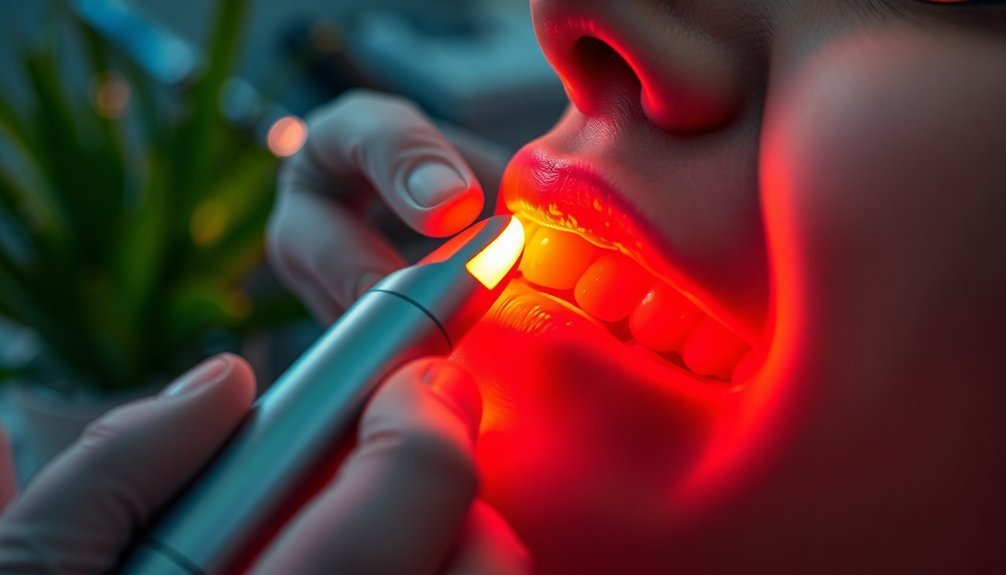
Understanding the mechanism of action behind gum disease treatment reveals how it effectively kickstarts your body's healing processes. NIR therapy exposes your affected gums to red and near-infrared light, penetrating deep into the tissue. This stimulates cellular activity, enhancing cell function and promoting the growth of new tissues while aiding in the differentiation of dental pulp stem cells.
The therapy boosts blood flow and circulation in your gum tissues, ensuring they receive essential nutrients and oxygen. It supports collagen production, which is crucial for tissue repair, and enhances oxygen delivery to damaged cells. Additionally, NIR therapy exhibits powerful anti-inflammatory effects, targeting inflammation to minimize swelling and pain associated with gum disease.
Here's a quick overview of how NIR therapy works:
| Mechanism | Description | Benefits |
|---|---|---|
| Stimulates Cell Activity | Uses light to enhance cellular function | Faster healing, tissue growth |
| Boosts Blood Flow | Improves circulation in gums | Better nutrient delivery |
| Reduces Inflammation | Targets and minimizes swelling | Less pain, controlled infection |
| Promotes Tissue Repair | Encourages regeneration of healthy tissue | Stronger gums |
Benefits of NIR Therapy
NIR therapy offers you accelerated healing by boosting your cells' energy production, which helps repair tissues more rapidly.
It also effectively reduces pain and inflammation, making your dental recovery much more comfortable.
This non-invasive treatment not only aids in faster healing but also enhances your overall oral health.
Accelerated Healing Process
When you prioritize your oral health, incorporating NIR therapy can greatly accelerate the healing process for gum disease. This cutting-edge treatment boosts blood circulation, increasing blood flow to affected areas and delivering more oxygen to your cells. Enhanced oxygen access promotes energy production, allowing your gum tissue to regenerate more effectively.
NIR therapy stimulates the growth of healthy gum tissue and supports the recovery of both soft tissue and bone after dental procedures. This means less gum recession and improved overall gum health. The therapy also aids in the delivery of essential nutrients and growth factors needed for ideal healing.
After dental procedures like extractions or surgeries, NIR therapy considerably speeds up recovery, reducing downtime and discomfort. You'll experience faster healing of oral tissues affected by conditions such as gingivitis and periodontitis.
Plus, the therapy enhances the outcomes of complex procedures like bone grafts and even orthodontic treatments.
Pain and Inflammation Reduction
By enhancing blood circulation and promoting tissue regeneration, NIR therapy also plays an important role in reducing pain and inflammation associated with gum disease. This therapy utilizes red light and near-infrared wavelengths to effectively target the inflammation present in your gums, often caused by gum disease and gingivitis.
Enhanced circulation delivers crucial oxygen and nutrients to the affected areas, supporting the healing process and helping to alleviate your discomfort.
Additionally, NIR therapy stimulates the activity of odontoblasts at the pulp-dentin interface, which can greatly reduce dental hypersensitivity. Studies reveal that 70-75% of patients experience reduced inflammation when using red light therapy during scaling and root planing procedures.
This non-invasive treatment is painless, with no reported side effects, making it a comfortable option for managing both pain and inflammation.
Regular use of NIR therapy can lead to noticeable improvements in your gum health. As you incorporate this therapy into your routine, you'll likely find that not only does it ease your pain, but it actively promotes healthier gums, resulting in an overall enhancement of your oral health.
Treatment Process
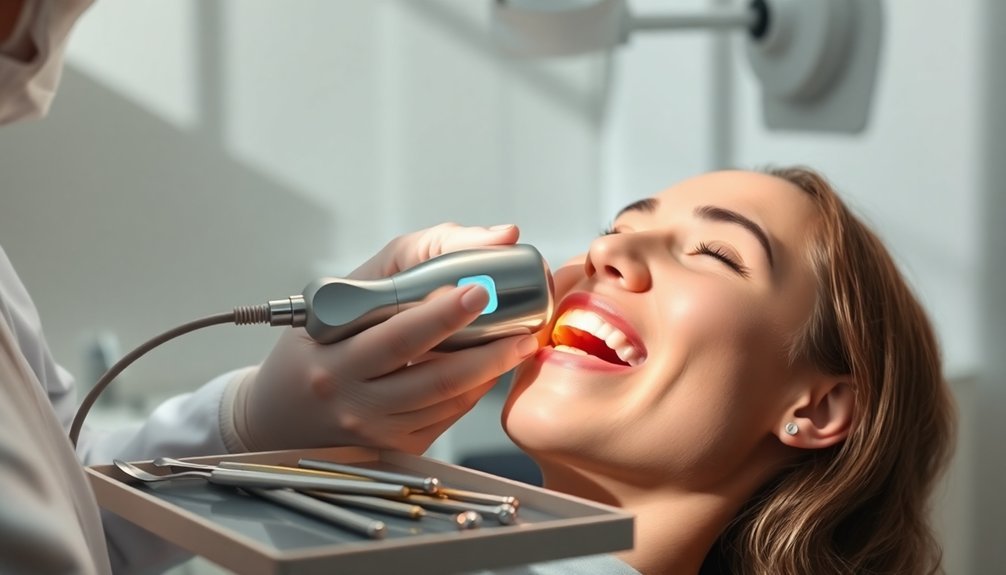
To effectively treat gum disease, it's crucial to follow a structured process that guarantees ideal results. Start by preparing your mouth: brush, floss, and rinse with mouthwash to guarantee effective light penetration.
Use a device designed for red and near-infrared light therapy (RLT/NIR) and follow the manufacturer's instructions for setup. Make sure the device is charged or plugged in and remove any barriers like food particles or plaque.
Next, apply the therapy by positioning the RLT/NIR device as instructed, often using a mouthguard-style fixture that fits over your teeth and gums. Shine the light directly onto the affected gum areas for 10-15 minutes, 3-5 times a week. You can adjust the frequency based on the severity of your gum disease.
To maximize benefits, consult with a dental professional to determine the appropriate number of sessions and treatment plan. Combine RLT/NIR with a solid oral hygiene routine for best results.
Monitor your progress and make adjustments based on how your oral health evolves. Regular follow-ups with your dentist will help assess treatment effectiveness and prevent further gum issues.
Targeted Gum Conditions
Understanding the specific types of gum conditions can greatly enhance your treatment strategy.
If you're dealing with periodontal disease, NIR therapy can considerably reduce inflammation by lowering the levels of inflammatory cytokines in your gums. It boosts cellular repair and regeneration by stimulating mitochondrial activity, which increases ATP production and improves blood circulation. This means more oxygen and nutrients reach the affected areas while possibly reducing the bacterial load in your mouth.
For gingivitis, NIR therapy helps reverse this early-stage gum disease by promoting healing and enhancing blood flow. You'll notice reduced swelling and tenderness, supporting overall oral hygiene, especially when combined with regular cleanings.
If you struggle with receding gums, therapy can stimulate tissue regeneration and reduce recession. It promotes faster healing and encourages collagen production, resulting in healthier gums. You can use this treatment daily for ideal results, with typical sessions lasting 10-15 minutes.
In cases of advanced periodontitis, while NIR therapy might help reduce inflammation and bacterial load, it may not be sufficient on its own. Complementary treatments like scaling and root planing might still be necessary.
Safety and Side Effects
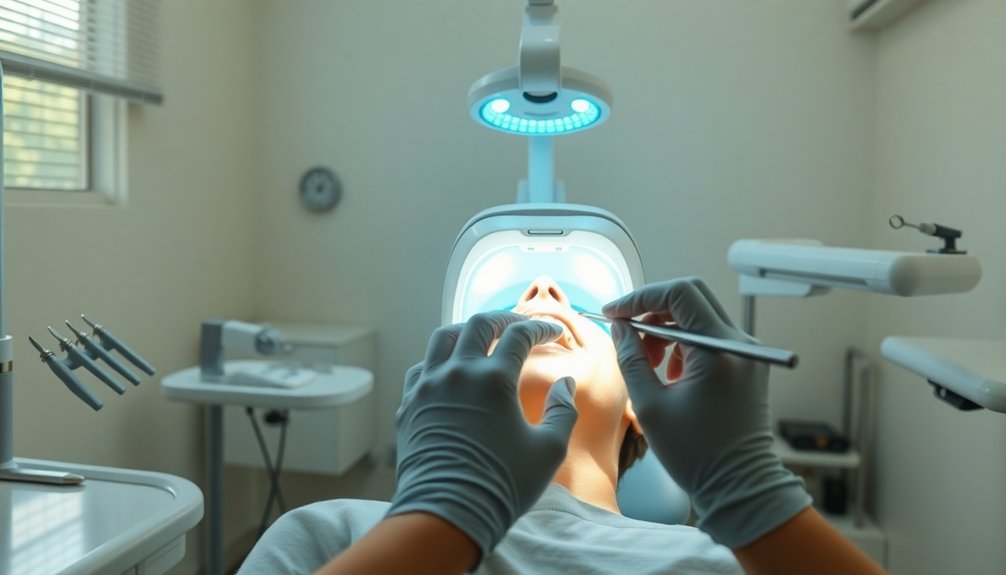
Safety is a essential consideration when exploring therapies for gum disease, and NIR therapy stands out for its non-invasive and well-tolerated nature. This treatment involves no heat and doesn't carry the surgical risks commonly associated with traditional methods, making it a comfortable option for most patients. In fact, you can use it daily when applied correctly.
One of the remarkable aspects of NIR therapy is the lack of significant side effects. You're unlikely to experience discomfort, and there have been no reports of severe adverse reactions. This makes it safe for long-term use, especially compared to more invasive treatments.
However, it's important to use NIR therapy under the guidance of a healthcare provider, especially if you have pre-existing oral conditions. Some specific health concerns may require special consideration, so consulting with your dentist is a must.
While you're following the proper usage guidelines, maintain good oral hygiene practices alongside the therapy.
Keep an eye on how your gums respond, and don't hesitate to report any unusual symptoms to your dentist. Regular check-ups can help guarantee your treatment plan remains effective and personalized.
Session Frequency and Duration
When it comes to treating gum disease with red light therapy, session frequency and duration play an important role in your overall success. Typically, you'll need to schedule sessions 3-5 times a week, but this can vary based on your individual oral health and treatment intensity. Regular sessions are critical for ideal results, and your dental professional can help determine the best frequency for you.
Each therapy session usually lasts between 10-15 minutes, although you might extend it up to 20 minutes if necessary. It's essential to maintain consistency in both frequency and duration for the best outcomes. Some cases may even require daily treatments to foster healing and gum regeneration.
Here's a quick reference table to guide you:
| Aspect | Recommendation |
|---|---|
| Session Frequency | 3-5 times a week |
| Session Duration | 10-15 minutes (up to 20 if needed) |
| Treatment Period | Varies from weeks to months |
| Follow-up Appointments | Regularly scheduled |
| Professional Guidance | Important for personalized care |
Keep in mind that your specific needs will dictate the exact regimen.
Combining NIR With Other Treatments
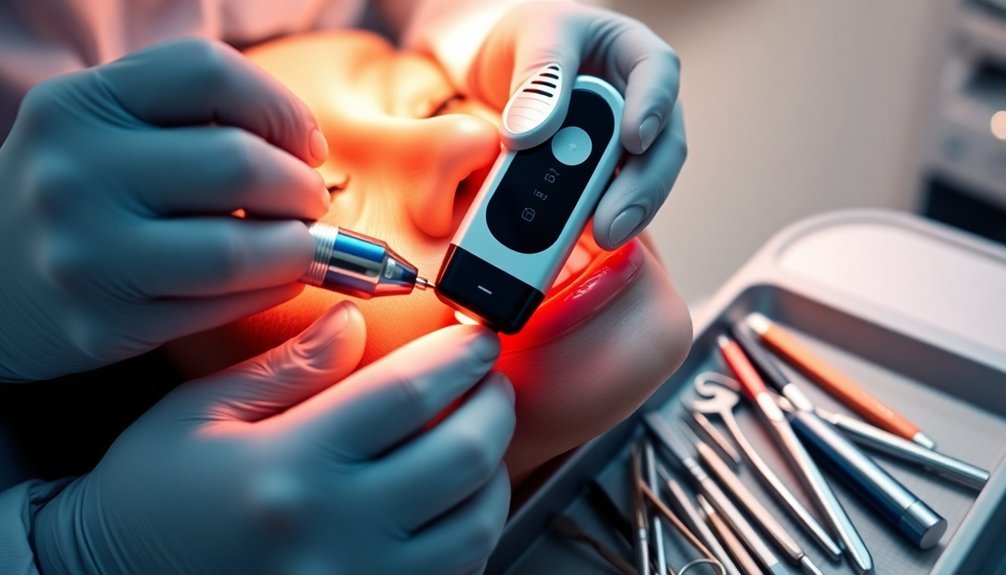
Combining near-infrared (NIR) light therapy with other treatments can greatly enhance the management of gum disease and improve overall oral health.
For instance, using NIR as an adjunct during hygiene appointments helps effectively treat chronic gingivitis, leading to better clinical outcomes. When combined with scaling and root planing, NIR therapy demonstrates improved results in managing severe periodontitis by reducing bacterial load and inflammatory markers.
NIR therapy also proves beneficial for endodontic treatments, such as root canal procedures, minimizing pain and facilitating healing. It works well as a complementary approach for treating primary teeth or pulpotomy, ensuring a higher success rate.
For those dealing with oral ulcerations, NIR effectively treats conditions like aphthous ulcers and mucositis, promoting faster recovery and reducing inflammation.
Additionally, when incorporated into regenerative and surgical procedures, it accelerates tissue healing, decreases postoperative discomfort, and supports bone regeneration.
Frequently Asked Questions
Is NIR Therapy Painful or Uncomfortable During Treatment?
NIR therapy isn't painful or uncomfortable during treatment. You'll likely feel relaxed as the gentle light stimulates your gum tissue. Most find the experience quite pleasant, with minimal to no side effects afterward.
Can I Eat or Drink Before and After the Session?
You don't need to avoid eating or drinking before or after your session. Just guarantee you maintain good oral hygiene and avoid sugary or acidic foods to keep your mouth clean and healthy afterward.
How Long Until I See Results From NIR Therapy?
You might notice improvements in gum sensitivity and inflammation within a few weeks. Consistent treatment is key for seeing results, but individual responses vary based on your specific oral health needs and issues.
Are There Any Specific Patients Who Should Avoid NIR Therapy?
Yes, certain patients should avoid NIR therapy, especially those with active infections, brain conditions, or hyperthyroidism. Always consult your healthcare provider to evaluate your specific health status and determine the best approach for you.
Can NIR Therapy Be Used for Children With Gum Disease?
Yes, NIR therapy can be used for children with gum disease. It safely reduces bacteria, enhances healing, and improves treatment outcomes, making it a beneficial option alongside traditional dental care. You'll notice positive results in their oral health.
In Summary
To sum up, NIR therapy can be a game-changer for treating gum disease. By effectively targeting the underlying issues, it promotes healing and reduces inflammation. You'll appreciate how safe and non-invasive the treatment is, making it an ideal option along with other therapies. Remember to consult your dental professional about the best approach for your specific needs. With consistent sessions and care, you can achieve healthier gums and a brighter smile in no time!

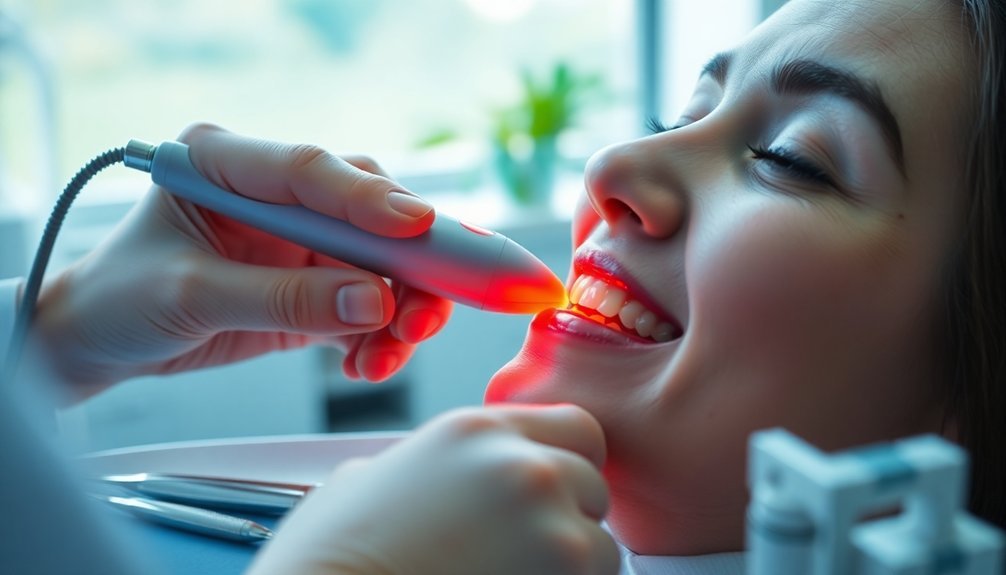



Leave a Reply